stop start Seat Ibiza ST 2010 Owner's Guide
[x] Cancel search | Manufacturer: SEAT, Model Year: 2010, Model line: Ibiza ST, Model: Seat Ibiza ST 2010Pages: 264, PDF Size: 7.11 MB
Page 155 of 264
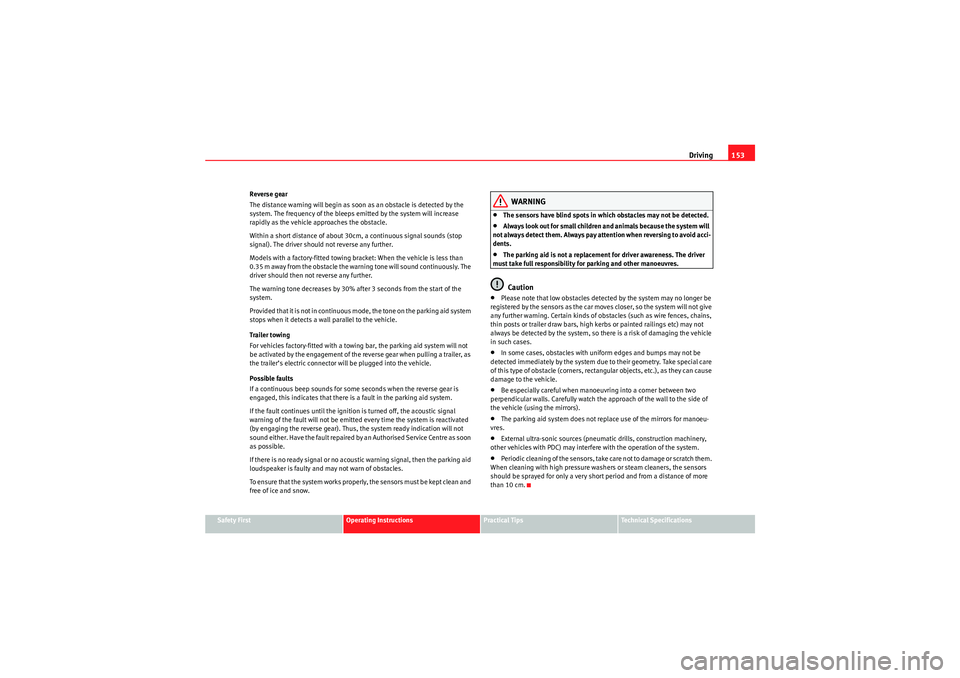
Driving153
Safety First
Operating Instructions
Practical Tips
Technical Specifications
Reverse gear
The distance warning will begin as soon as an obstacle is detected by the
system. The frequency of the bleeps emitted by the system will increase
rapidly as the vehicle approaches the obstacle.
Within a short distance of about 30cm, a continuous signal sounds (stop
signal). The driver should not reverse any further.
Models with a factory-fitted towing bracket: When the vehicle is less than
0.35 m away from the obstacle the warning tone will sound continuously. The
driver should then not reverse any further.
The warning tone decreases by 30% after 3 seconds from the start of the
system.
Provided that it is not in continuous mode, the tone on the parking aid system
stops when it detects a wall parallel to the vehicle.
Trailer towing
For vehicles factory-fitted with a towing bar, the parking aid system will not
be activated by the engagement of the reverse gear when pulling a trailer, as
the trailer’s electric connector will be plugged into the vehicle.
Possible faults
If a continuous beep sounds for some seconds when the reverse gear is
engaged, this indicates that there is a fault in the parking aid system.
If the fault continues until the ignition is turned off, the acoustic signal
warning of the fault will not be emitted every time the system is reactivated
(by engaging the reverse gear). Thus, the system ready indication will not
sound either. Have the fault repaired by an Authorised Service Centre as soon
as possible.
If there is no ready signal or no acoustic warning signal, then the parking aid
loudspeaker is faulty and may not warn of obstacles.
To ensure that the system works properly, the sensors must be kept clean and
free of ice and snow.
WARNING
•The sensors have blind spots in which obstacles may not be detected.•Always look out for small children and animals because the system will
not always detect them. Always pay attention when reversing to avoid acci-
dents.•The parking aid is not a replacement for driver awareness. The driver
must take full responsibility for parking and other manoeuvres.Caution
•Please note that low obstacles detected by the system may no longer be
registered by the sensors as the car moves closer, so the system will not give
any further warning. Certain kinds of obstacles (such as wire fences, chains,
thin posts or trailer draw bars, high kerbs or painted railings etc) may not
always be detected by the system, so there is a risk of damaging the vehicle
in such cases.•In some cases, obstacles with uniform edges and bumps may not be
detected immediately by the system due to their geometry. Take special care
of this type of obstacle (corners, rectangular objects, etc.), as they can cause
damage to the vehicle.•Be especially careful when manoeuvring into a corner between two
perpendicular walls. Carefully watch the approach of the wall to the side of
the vehicle (using the mirrors).•The parking aid system does not replace use of the mirrors for manoeu-
vres.•External ultra-sonic sources (pneumatic drills, construction machinery,
other vehicles with PDC) may interfere with the operation of the system.•P e r i o d i c c le a n i n g o f t h e s e ns o r s , ta ke ca r e n o t to d a m a ge o r s cr a tch t h e m .
When cleaning with high pressure washers or steam cleaners, the sensors
should be sprayed for only a very short period and from a distance of more
than 10 cm.
IbizaST_EN.book Seite 153 Dienstag, 14. September 2010 1:31 13
Page 170 of 264
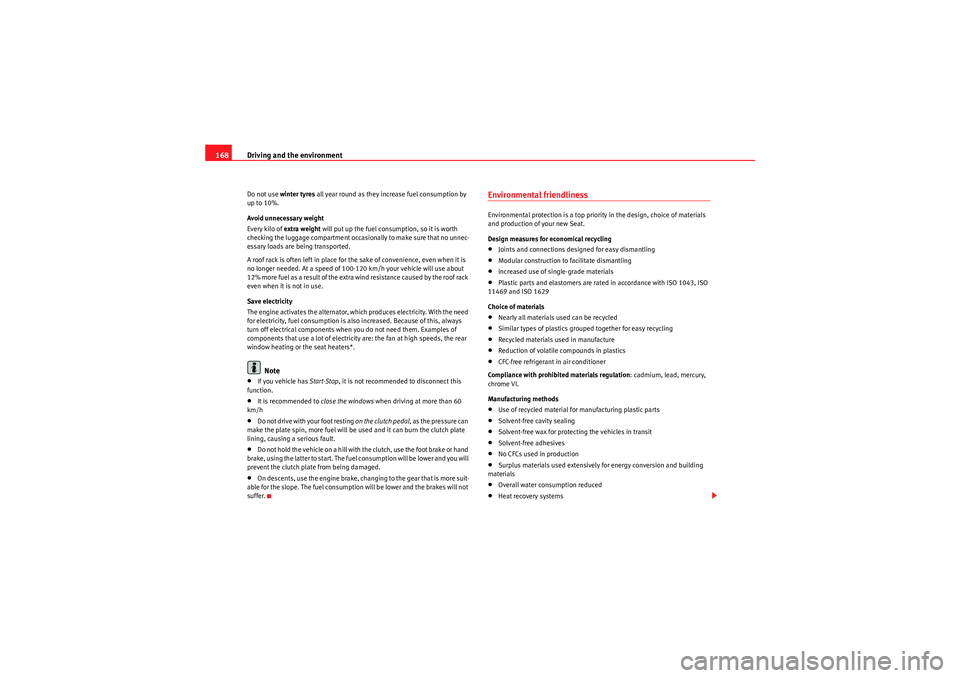
Driving and the environment
168Do not use winter tyres all year round as they increase fuel consumption by
up to 10%.
Avoid unnecessary weight
Every kilo of extra weight will put up the fuel consumption, so it is worth
checking the luggage compartment occasionally to make sure that no unnec-
essary loads are being transported.
A roof rack is often left in place for the sake of convenience, even when it is
no longer needed. At a speed of 100-120 km/h your vehicle will use about
12% more fuel as a result of the extra wind resistance caused by the roof rack
even when it is not in use.
Save electricity
The engine activates the alternator, which produces electricity. With the need
for electricity, fuel consumption is also increased. Because of this, always
turn off electrical components when you do not need them. Examples of
components that use a lot of electricity are: the fan at high speeds, the rear
window heating or the seat heaters*.
Note
•If you vehicle has Start-Stop, it is not recommended to disconnect this
function.•It is recommended to close the windows when driving at more than 60
km/h•Do not drive with your foot resting on the clutch pedal, as the pressure can
make the plate spin, more fuel will be used and it can burn the clutch plate
lining, causing a serious fault.•Do not hold the vehicle on a hill with the clutch, use the foot brake or hand
brake, using the latter to start. The fuel consumption will be lower and you will
prevent the clutch plate from being damaged.•On descents, use the engine brake, changing to the gear that is more suit-
able for the slope. The fuel consumption will be lower and the brakes will not
suffer.
Environmental friendlinessEnvironmental protection is a top priority in the design, choice of materials
and production of your new Seat.
Design measures for economical recycling•Joints and connections designed for easy dismantling•Modular construction to facilitate dismantling•Increased use of single-grade materials•Plastic parts and elastomers are rated in accordance with ISO 1043, ISO
11469 and ISO 1629
Choice of materials•Nearly all materials used can be recycled•Similar types of plastics grouped together for easy recycling•Recycled materials used in manufacture•Reduction of volatile compounds in plastics•CFC-free refrigerant in air conditioner
Compliance with prohibited materials regulation : cadmium, lead, mercury,
chrome VI.
Manufacturing methods•Use of recycled material for manufacturing plastic parts•Solvent-free cavity sealing•Solvent-free wax for protecting the vehicles in transit•Solvent-free adhesives•No CFCs used in production•Surplus materials used extensively for energy conversion and building
materials•Overall water consumption reduced•Heat recovery systems
IbizaST_EN.book Seite 168 Dienstag, 14. September 2010 1:31 13
Page 195 of 264
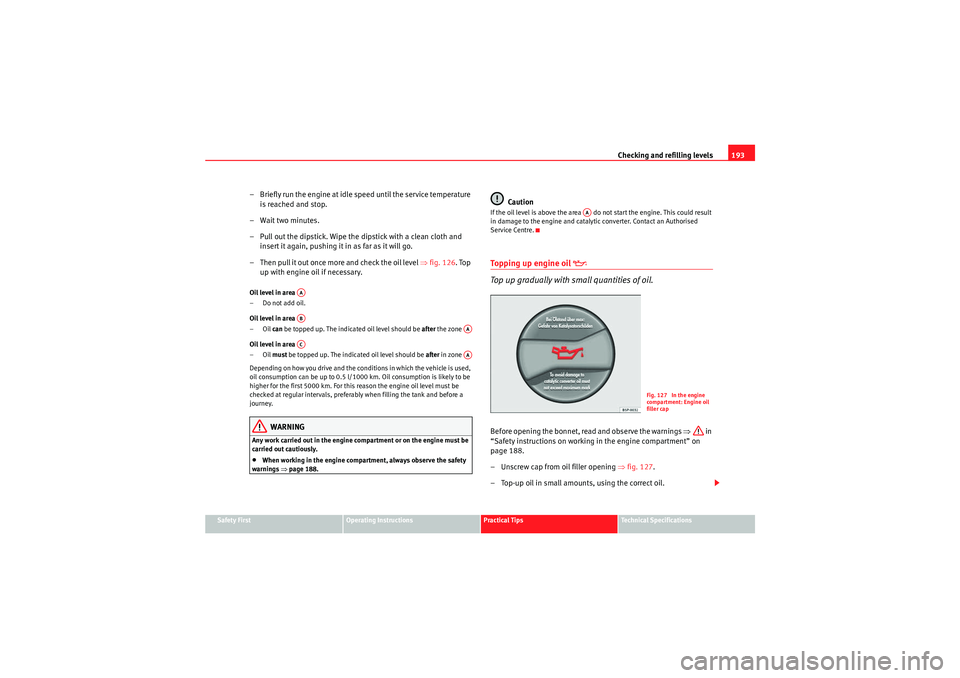
Checking and refilling levels193
Safety First
Operating Instructions
Practical Tips
Technical Specifications
– Briefly run the engine at idle speed until the service temperature
is reached and stop.
– Wait two minutes.
– Pull out the dipstick. Wipe the dipstick with a clean cloth and insert it again, pushing it in as far as it will go.
– Then pull it out once more and check the oil level ⇒ fig. 126. Top
up with engine oil if necessary.Oil level in area
–Do not add oil.
Oil level in area
–Oil can be topped up. The indicated oil level should be after the zone
Oil level in area
–Oil must be topped up. The indicated oil level should be after in zone
Depending on how you drive and the conditions in which the vehicle is used,
oil consumption can be up to 0.5 l/1000 km. Oil consumption is likely to be
higher for the first 5000 km. For this reason the engine oil level must be
checked at regular intervals, preferably when filling the tank and before a
journey.
WARNING
Any work carried out in the engine compartment or on the engine must be
carried out cautiously.•When working in the engine compartment, always observe the safety
warnings ⇒page 188.
Caution
If the oil level is above the area do not start the engine. This could result
in damage to the engine and catalytic converter. Contact an Authorised
Service Centre.Topping up engine oil
�E
Top up gradually with small quantities of oil.
Before opening the bonnet, read and observe the warnings ⇒ in
“Safety instructions on working in the engine compartment” on
page 188.
– Unscrew cap from oil filler opening ⇒fig. 127 .
– Top-up oil in small amounts, using the correct oil.
AAAB
AA
AC
AA
AA
Fig. 127 In the engine
compartment: Engine oil
filler cap
IbizaST_EN.book Seite 193 Dienstag, 14. September 2010 1:31 13
Page 206 of 264
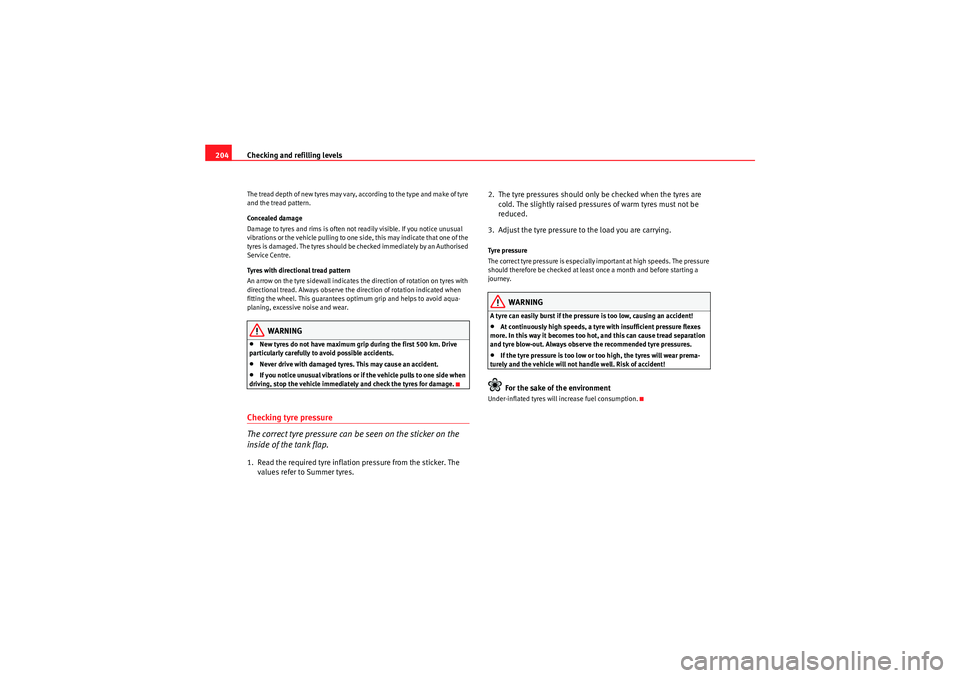
Checking and refilling levels
204The tread depth of new tyres may vary, according to the type and make of tyre
and the tread pattern.
Concealed damage
Damage to tyres and rims is often not readily visible. If you notice unusual
vibrations or the vehicle pulling to one side, this may indicate that one of the
tyres is damaged. The tyres should be checked immediately by an Authorised
Service Centre.
Tyres with directional tread pattern
An arrow on the tyre sidewall indicates the direction of rotation on tyres with
directional tread. Always observe the direction of rotation indicated when
fitting the wheel. This guarantees optimum grip and helps to avoid aqua-
planing, excessive noise and wear.
WARNING
•New tyres do not have maximum grip during the first 500 km. Drive
particularly carefully to avoid possible accidents.•Never drive with damaged tyres. This may cause an accident.•If you notice unusual vibrations or if the vehicle pulls to one side when
driving, stop the vehicle immediately and check the tyres for damage.
Checking tyre pressure
The correct tyre pressure can be seen on the sticker on the
inside of the tank flap.1. Read the required tyre inflation pressure from the sticker. The values refer to Summer tyres. 2. The tyre pressures should only be checked when the tyres are
cold. The slightly raised pressu res of warm tyres must not be
reduced.
3. Adjust the tyre pressure to the load you are carrying.
Tyre pressure
The correct tyre pressure is especially important at high speeds. The pressure
should therefore be checked at least once a month and before starting a
journey.
WARNING
A tyre can easily burst if the pressure is too low, causing an accident!•At continuously high speeds, a tyre with insufficient pressure flexes
more. In this way it becomes too hot, and this can cause tread separation
and tyre blow-out. Always observe the recommended tyre pressures.•If the tyre pressure is too low or too high, the tyres will wear prema-
turely and the vehicle will not handle well. Risk of accident!For the sake of the environment
Under-inflated tyres will increase fuel consumption.
IbizaST_EN.book Seite 204 Dienstag, 14. September 2010 1:31 13
Page 222 of 264
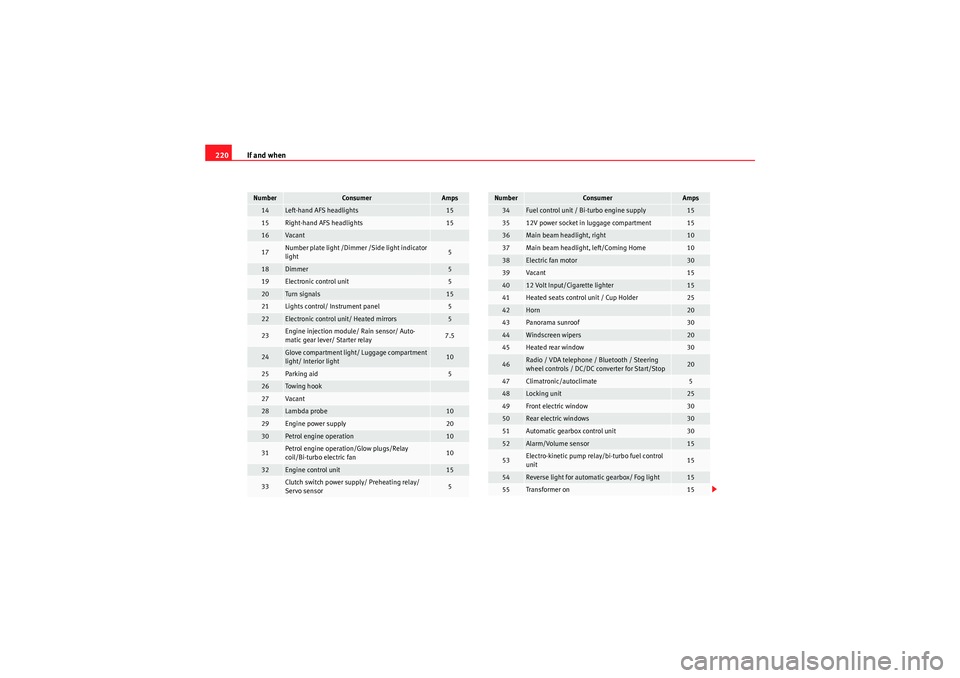
If and when
220
14
Left-hand AFS headlights
15
15
Right-hand AFS headlights
15
16
Vaca n t
17
Number plate light /Dimmer /Side light indicator
light
5
18
Dimmer
5
19
Electronic control unit
5
20
Turn signals
15
21
Lights control/ Instrument panel
5
22
Electronic control unit/ Heated mirrors
5
23
Engine injection module/ Rain sensor/ Auto-
matic gear lever/ Starter relay
7.5
24
Glove compartment light/ Luggage compartment
light/ Interior light
10
25
Parking aid
5
26
Towing hook
27
Vaca n t
28
Lambda probe
10
29
Engine power supply
20
30
Petrol engine operation
10
31
Petrol engine operation/Glow plugs/Relay
coil/Bi-turbo electric fan
10
32
Engine control unit
15
33
Clutch switch power supply/ Preheating relay/
Servo sensor
5
Number
Consumer
Amps
34
Fuel control unit / Bi-turbo engine supply
15
35
12V power socket in luggage compartment
15
36
Main beam headlight, right
10
37
Main beam headlight, left/Coming Home
10
38
Electric fan motor
30
39
Vaca n t
15
40
12 Volt Input/Cigarette lighter
15
41
Heated seats control unit / Cup Holder
25
42
Horn
20
43
Panorama sunroof
30
44
Windscreen wipers
20
45
Heated rear window
30
46
Radio / VDA telephone / Bluetooth / Steering
wheel controls / DC/DC converter for Start/Stop
20
47
Climatronic/autoclimate
5
48
Locking unit
25
49
Front electric window
30
50
Rear electric windows
30
51
Automatic gearbox control unit
30
52
Alarm/Volume sensor
15
53
Electro-kinetic pump relay/bi-turbo fuel control
unit
15
54
Reverse light for automatic gearbox/ Fog light
15
55
Transformer on
15
Number
Consumer
Amps
IbizaST_EN.book Seite 220 Dienstag, 14. September 2010 1:31 13
Page 234 of 264

If and when
232Jump leads
Jump leads must comply with standard DIN 72553 (see manufacturer’s docu-
mentation). The wire cross section must be at least 25 mm
2 for petrol engines
and at least 35 mm
2 for diesel engines.
Note
•The vehicles must not touch each other, otherwise electricity could flow as
soon as the positive terminals are connected.•The discharged battery must be properly connected to the vehicle elec-
trical system.How to jump start: description
Jump lead terminal connections
1. Switch off the ignition of both vehicles ⇒.
2. Connect one end of the red jump lead to the positive terminal
⇒ fig. 163 or ⇒fig. 164 of the vehicle with the flat
battery .
3. Connect the other end of the red jump lead to the positive
terminal in the vehicle providing assistance .
4. On vehicles with no Start-Stop system , connect one end of the
black jump lead to the negative terminal in the vehicle
providing assistance ⇒fig. 163 .
5. On vehicles with the Start-Stop system , connect one end of the
black jump lead to a suitable ground terminal, to a solid metal
part bolted to the engine block or to the engine block itself
⇒ fig. 164 .
Fig. 163 Diagram for
connecting jump leads if
the vehicle providing
assistance the current is
not fitted with the Start-
Stop system: flat battery
and battery providing
current .AA
AB
Fig. 164 Diagram for
connecting jump leads if
the vehicle providing
assistance is fitted with
the Start-Stop system:
flat battery and
battery providing current .
AA
AB
A+
A+
AAA+
AB
A-
AB
AX
IbizaST_EN.book Seite 232 Dienstag, 14. September 2010 1:31 13
Page 247 of 264
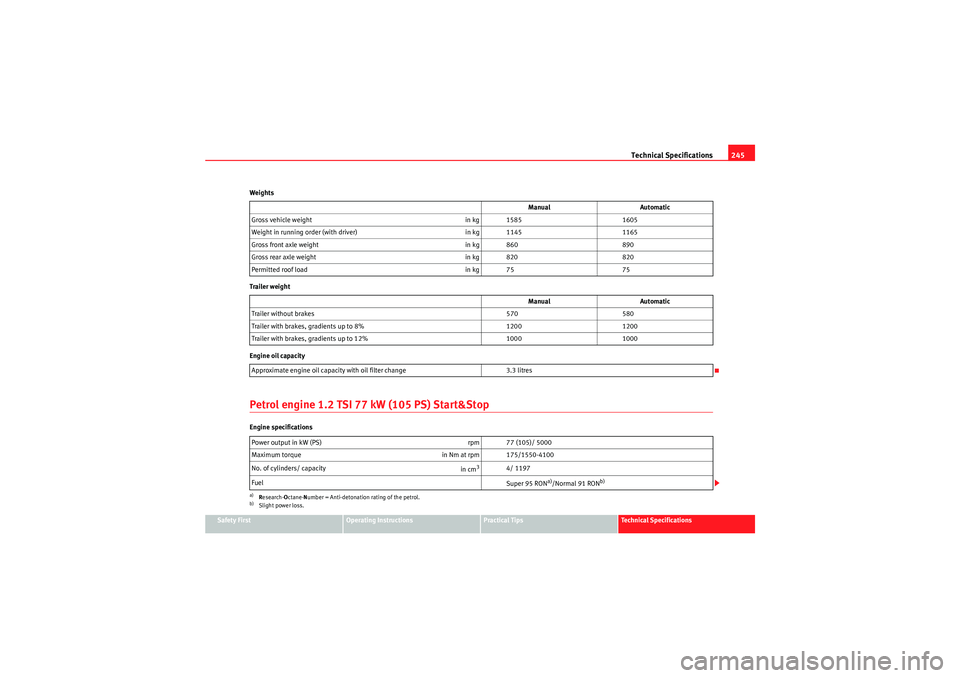
Technical Specifications245
Safety First
Operating Instructions
Practical Tips
Technical Specifications
Weights
Trailer weight
Engine oil capacity
Petrol engine 1.2 TSI 77 kW (105 PS) Start&StopEngine specifications
Manual
Automatic
Gross vehicle weight in kg 15851605
Weight in running order (with driver) in kg 11451165
Gross front axle weight in kg 860890
Gross rear axle weight in kg 820820
Permitted roof load in kg 7575
Manual Automatic
Trailer without brakes 570580
Trailer with brakes, gradients up to 8% 12001200
Trailer with brakes, gradients up to 12% 10001000
Approximate engine oil capacity with oil filter change 3.3 litres
Power output in kW (PS) rpm 77 (105)/ 5000
Maximum torque in Nm at rpm 175/1550-4100
No. of cylinders/ capacity in cm
3
4/ 1197
Fuel Super 95 RON
a)/Normal 91 RON
b)
a)Research- Octane- Number = Anti-detonation rating of the petrol.b)Slight power loss.
IbizaST_EN.book Seite 245 Dienstag, 14. September 2010 1:31 13
Page 249 of 264
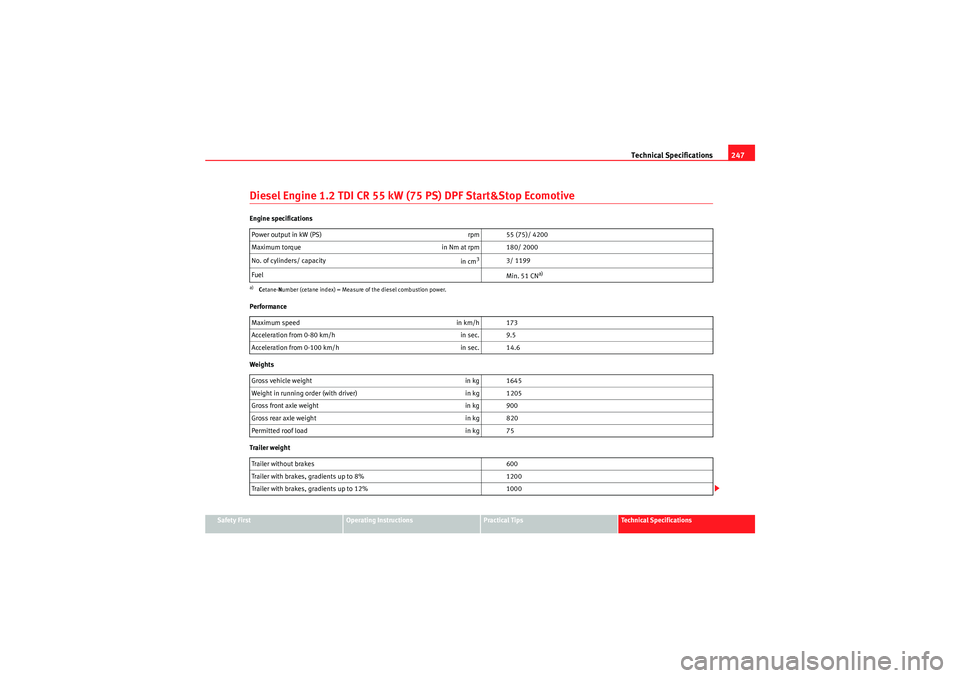
Technical Specifications247
Safety First
Operating Instructions
Practical Tips
Technical Specifications
Diesel Engine 1.2 TDI CR 55 kW (75 PS) DPF Start&Stop EcomotiveEngine specifications
Performance
Weights
Trailer weightPower output in kW (PS)
rpm 55 (75)/ 4200
Maximum torque in Nm at rpm 180/ 2000
No. of cylinders/ capacity in cm
3
3/ 1199
Fuel Min. 51 CN
a)
a)Cetane- Number (cetane index) = Measure of the diesel combustion power.Maximum speed in km/h 173
Acceleration from 0-80 km/h in sec. 9.5
Acceleration from 0-100 km/h in sec. 14.6
Gross vehicle weight in kg 1645
Weight in running order (with driver) in kg 1205
Gross front axle weight in kg 900
Gross rear axle weight in kg 820
Permitted roof load in kg 75
Trailer without brakes 600
Trailer with brakes, gradients up to 8% 1200
Trailer with brakes, gradients up to 12% 1000
IbizaST_EN.book Seite 247 Dienstag, 14. September 2010 1:31 13
Page 261 of 264

Index259
Spare wheel . . . . . . . . . . . . . . . . . . . . . . . . . . . . 210
Speed selector lever lock
Warning lamp . . . . . . . . . . . . . . . . . . . . . . . . . 66
Speedometer . . . . . . . . . . . . . . . . . . . . . . . . . . . . 52
Starting Petrol engines . . . . . . . . . . . . . . . . . . . 138
Starting petrol engines . . . . . . . . . . . . . . . . . . . 138
Starting the engine . . . . . . . . . . . . . . . . . . . . . . 138 After the fuel tank has been run dry . . . . . . 139
Start-Stop Function . . . . . . . . . . . . . . . . . . . . . . . . . . . . 140
Switching on and off . . . . . . . . . . . . . . . . . . 141
Steam jets . . . . . . . . . . . . . . . . . . . . . . . . . . . . . 174
Steering . . . . . . . . . . . . . . . . . . . . . . . . . . . . . . . 135 Steering lock . . . . . . . . . . . . . . . . . . . . . . . . 136
Steering column controls Audio Control . . . . . . . . . . . . . . . . . . . . . . . . . 70
Steering wheel height adjustment . . . . . . . . . . 135
Storage compartment . . . . . . . . . . . . . . . . . . . . 123 Front passenger side . . . . . . . . . . . . . . . . . . 112
front seat . . . . . . . . . . . . . . . . . . . . . . . . . . . 114
Sun visor Sliding/tilting sunroof . . . . . . . . . . . . . . . . . . 89
Sun visors . . . . . . . . . . . . . . . . . . . . . . . . . . . . . . . 99
Switch Hazard warning lights . . . . . . . . . . . . . . . . . . 96
Heated rear window . . . . . . . . . . . . . . . . . . . . 95
Light switch . . . . . . . . . . . . . . . . . . . . . . . . . . 91
Switches Electric windows . . . . . . . . . . . . . . . . . . . . . . 86
Sliding/tilting sunroof . . . . . . . . . . . . . . . . . . 89
Switching off the engine . . . . . . . . . . . . . . . . . . 139
TTailgate . . . . . . . . . . . . . . . . . . . . . . . . . . . . . . . . . 84 Emergency opening . . . . . . . . . . . . . . . . . . . . 85
Warning lamp . . . . . . . . . . . . . . . . . . . . . . . . . 67
Tank Fuel level . . . . . . . . . . . . . . . . . . . . . . . . . . . . 52
Reserve indicator . . . . . . . . . . . . . . . . . . . . . . 52
Tank capacity . . . . . . . . . . . . . . . . . . . . . . . . . 52
TCS . . . . . . . . . . . . . . . . . . . . . . . . . . . . . . . . . . . 160
TCS (Traction control system) Warning lamp . . . . . . . . . . . . . . . . . . . . . . . . . 64
Technical modifications . . . . . . . . . . . . . . . . . . 181
The danger of not using the seat belt . . . . . . . . 20
Tightening torque of wheel bolts . . . . . . . . . . . 240
Tilting sunroof . . . . . . . . . . . . . . . . . . . . . . . . . . . 89
Tools . . . . . . . . . . . . . . . . . . . . . . . . . . . . . . . . . . 210
Top Tether system . . . . . . . . . . . . . . . . . . . . . . . . 45
Tow starting Comments . . . . . . . . . . . . . . . . . . . . . . . . . . 234
Towing . . . . . . . . . . . . . . . . . . . . . . . . . . . . . . . . 234
Towing a trailer . . . . . . . . . . . . . . . . . . . . 169, 239
Towing bracket . . . . . . . . . . . . . . . . . . . . . . . . . 170
Towing bracket, fitting . . . . . . . . . . . . . . . . . . . 183
Towing eye . . . . . . . . . . . . . . . . . . . . . . . . . . . . . 234
Towing eyes . . . . . . . . . . . . . . . . . . . . . . . . . . . . 235
Tow-starting . . . . . . . . . . . . . . . . . . . . . . . . . . . . 234
Traction control system Warning lamp . . . . . . . . . . . . . . . . . . . . . . . . . 64 Trailer turn signals
Warning lamp . . . . . . . . . . . . . . . . . . . . . . . . 97
Trailer weights . . . . . . . . . . . . . . . . . . . . . . . . . . 239
Turn signals . . . . . . . . . . . . . . . . . . . . . . . . . . . . . 97 Indicator lamp . . . . . . . . . . . . . . . . . . . . . . . . 68
Warning lamp . . . . . . . . . . . . . . . . . . . . . . . . 97
Two-way radio . . . . . . . . . . . . . . . . . . . . . . . . . . 182
Tyre Mobility-System (Tyre repair kit) . . . . . . . . 211
Tyre pressure . . . . . . . . . . . . . . . . . . . . . . . . . . . 204 Warning lamp . . . . . . . . . . . . . . . . . . . . . . . . 65
Tyre pressures . . . . . . . . . . . . . . . . . . . . . . . . . . 240
Tyre repair kit . . . . . . . . . . . . . . . . . . . . . . 211, 216
Tyre-Mobility-System (Tyre repair kit) . . . . . . . . 216
Tyres and wheels Dimensions . . . . . . . . . . . . . . . . . . . . . . . . . 206
Tyres service life . . . . . . . . . . . . . . . . . . . . . . . . 205
Tyres tread depth . . . . . . . . . . . . . . . . . . . . . . . . 205
Tyres with directional tread pattern . . . . . . . . . 204
UUnderbody protection . . . . . . . . . . . . . . . . . . . . 178VVehicle battery . . . . . . . . . . . . . . . . . . . . . . . . . . 201
Vehicle data . . . . . . . . . . . . . . . . . . . . . . . . . . . . 238
Vehicle identification data . . . . . . . . . . . . . . . . 238
Vehicle identification number . . . . . . . . . . . . . 238
Vehicle interior heating or cooling system . . . 129
Vehicle modifications . . . . . . . . . . . . . . . . . . . . 181
IbizaST_EN.book Seite 259 Dienstag, 14. September 2010 1:31 13